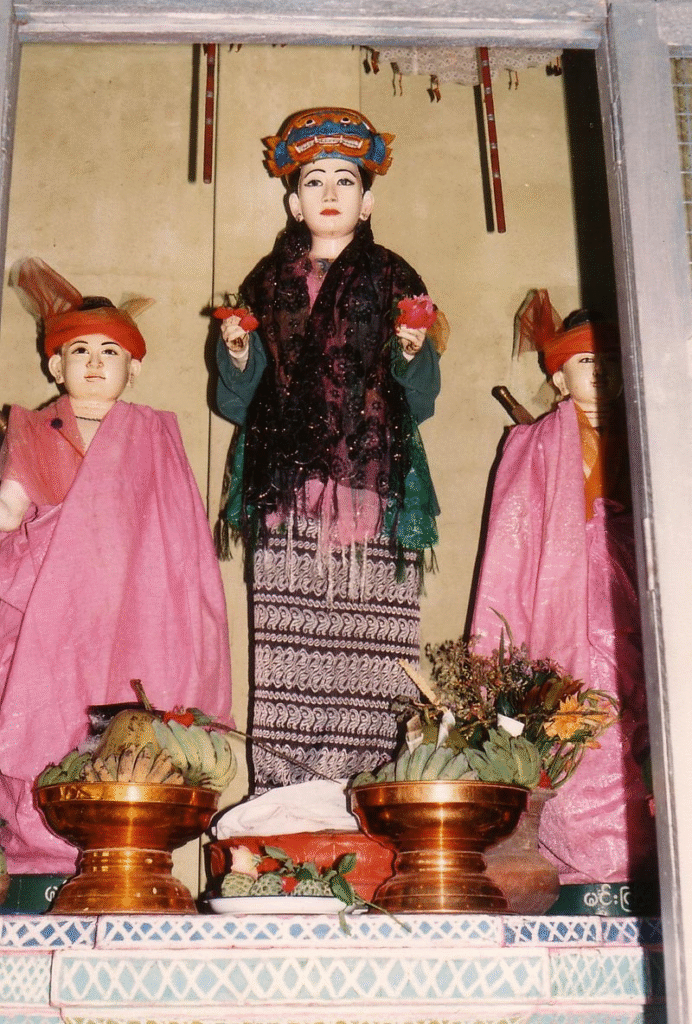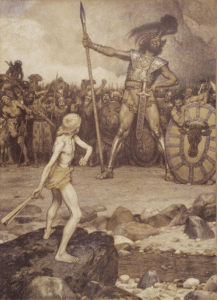Unscrupulous Wikipedians sometimes ignorantly deleted this as IRRELEVANT with Islam, without knowing the history of early arrival of Islam to Myanmar.

A shrine to the Shwe Hypin brothers and their mother Me Wunna at Mount Popa
By Wagaung, CC BY-SA 3.0, https://commons.wikimedia.org/w/index.php?curid=18144580
Deified Muslim Figures
In addition to the well-known figures of Byatta and the Shwe Hpyin brothers, several Islamic saints have been historically venerated along Myanmar’s coastal regions in a syncretic tradition that transcends religious boundaries. These figures, often associated with miraculous powers and maritime protection, are revered not only by Muslims but also by Buddhists and animist communities.
ဗုဒ္ဒေါမောကန် (သို့) မွတ်စလင်မ် သူတော်စဉ်ကြီးအကြောင်း
One notable example is Badr al-Din Auliya, a saint whose shrine is located near the coast and is locally referred to as a ဗုဒ္ဒေါမောကန် (Buddha Mawkan). Despite the name’s Buddhist connotation, the shrine is dedicated to a Muslim figure and is visited by people of various faiths seeking blessings, healing, and protection from sea dangers. Similar shrines exist for other Islamic saints whose graves are found along the Bay of Bengal coastline, particularly in Rakhine State and parts of Tanintharyi Region.
These shrines reflect a longstanding tradition of cross-faith veneration, where Muslim saints are revered as protective spirits or nats—a practice rooted in local beliefs and maritime culture. The phenomenon parallels similar traditions in South and Southeast Asia, such as the Panch Pir worship in Bengal and Keramat shrines in Malaysia.
Although these practices may appear unorthodox from a doctrinal Islamic perspective, they underscore the historical depth and cultural integration of Islam in Myanmar, dating back to early trade routes and Sufi missionary activity in the region. Their continued veneration by non-Muslims highlights the complex spiritual landscape of Myanmar and the enduring legacy of Islamic saints in local folklore and communal memory.
The coastal shrines of Badr al-Din Auliya and other Islamic saints in Burma—known locally as ဗုဒ္ဒေါမောကန်—are venerated by Buddhists and non-Muslims, reflecting a unique syncretic tradition.
This phenomenon, though underrepresented in mainstream narratives, reveals a fascinating intersection of maritime history, spiritual reverence, and cultural hybridity along Myanmar’s coast:
Coastal Shrines of Islamic Saints in Burma
- Badr al-Din Auliya, often referred to as the Sultan of Water, is one of several saints whose shrines dot the Bay of Bengal coast. His legacy is especially strong in Chittagong, but similar reverence extends into Rakhine and Tanintharyi regions of Myanmar.
- These shrines are part of a broader tradition of “Panch Pir” (Five Saints) worship, where Muslim saints are invoked for protection—especially by fishermen and coastal communities—regardless of religious affiliation.
- The Burmese term ဗုဒ္ဒေါမောကန် (pronounced “Buddha Mawkan”) is a syncretic label, blending Buddhist and Islamic connotations. It suggests a localized spiritual identity, where saints are revered as protective spirits or nats, akin to indigenous animist beliefs.
Syncretism and Cross-Faith Veneration
- These shrines are visited by Buddhists, Hindus, and animists, who offer candles, flowers, and coconut oil—rituals that echo both Islamic and local traditions.
- The veneration is often pragmatic and spiritual, tied to protection from sea dangers, healing, and blessings, rather than doctrinal Islam.
- This practice mirrors other Southeast Asian coastal traditions, such as the Keramat shrines in Malaysia or Pirs in Bengal, where saints transcend religious boundaries.
Historical Roots
- From the 14th to 16th centuries, Muslim traders and Sufi missionaries settled along Burma’s coast, establishing shrines and spiritual centers.
- These saints were often associated with miraculous powers, especially over water, which made them revered figures among seafaring communities.
- Over time, their shrines became cultural landmarks, blending Islamic, Buddhist, and animist elements.
Read also: Byatta, Shwe Hpyin Naungdaw, and Shwe Hpyin Nyidaw





